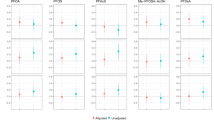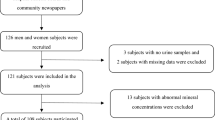Abstract
Background/Objectives:
Exposure to polycyclic aromatic hydrocarbons (PAHs) during pregnancy is known to increase oxidative stress, which may influence pregnancy outcomes and health of the child.
Subjects/Methods:
This study investigated whether fruit and vegetable intake modifies the relationship between exposure to PAHs and oxidative stress status during pregnancy. Urinary levels of 2-naphthol and 1-hydroxypyrene (biomarkers of exposure to PAHs), and malondialdehyde (MDA; a biomarker of oxidative stress) were analyzed in 715 pregnant women at 12–28 weeks of gestation. The dietary antioxidant intake during pregnancy was estimated using the 24-h recall method. Urinary 2-naphthol, 1-hydroxypyrene and MDA levels were analyzed by high-performance liquid chromatography–fluorescence detection.
Results:
The urinary MDA level was positively correlated with the 2-naphthol level (r=0.255, P<0.001) and 1-hydroxypyrene level (r=0.240, P<0.001). Multiple regression analysis after adjustment for covariates revealed that the urinary 1-hydroxypyrene level was positively associated with the MDA level; these positive associations only existed in pregnant women, with either the fruit and vegetable intake or the vitamin C intake in the first tertile (<390.1 g/day) or in the first and second tertiles (<141.5 mg/day), respectively.
Conclusions:
These results suggest that an adequate maternal intake of fruit, vegetables and vitamin C is beneficial to the defense against the oxidative stress associated with exposure to PAHs in pregnant women.
This is a preview of subscription content, access via your institution
Access options
Subscribe to this journal
Receive 12 print issues and online access
$259.00 per year
only $21.58 per issue
Buy this article
- Purchase on Springer Link
- Instant access to full article PDF
Prices may be subject to local taxes which are calculated during checkout
Similar content being viewed by others
References
Bae S, Pan XC, Kim SY, Park K, Kim YH, Kim H et al. (2010). Exposures to particulate matter and polycyclic aromatic hydrocarbons and oxidative stress in schoolchildren. Environ Health Perspect 118, 579–583.
Barber DA, Harris SR (1994). Oxygen free radicals and antioxidants: a review. Am Pharm NS 34, 26–35.
Biri A, Bozkurt N, Turp A, Kavutcu M, Himmetoglu O, Durak I (2007). Role of oxidative stress in intrauterine growth restriction. Gynecol Obstet Invest 64, 187–192.
Bolton JL, Trush MA, Penning TM, Dryhurst G, Monks TJ (2000). Role of quinones in toxicology. Chem Res Toxicol 13, 135–160.
Brantsaeter AL, Haugen M, Samuelsen SO, Torjusen H, Trogstad L, Alexander J et al. (2009). A dietary pattern characterized by high intake of vegetables, fruits, and vegetable oils is associated with reduced risk of preeclampsia in nulliparous pregnant Norwegian women. J Nutr 139, 1162–1168.
Castaño-Vinyals G, D’Errico A, Malats N, Kogevinas M (2004). Biomarkers of exposure to polycyclic aromatic hydrocarbons from environmental air pollution. Occup Environ Med 61, e12.
Caux C, O’Brien C, Viau C (2002). Determination of firefighter exposure to polycyclic aromatic hydrocarbons and benzene during fire fighting using measurement of biological indicators. Appl Occup Environ Hyg 17, 379–386.
Choi H, Perera FP (2011). Sources of greater fetal vulnerability to airborne polycyclic aromatic hydrocarbons among African Americans. J Epidemiol Community Health; e-pub ahead of print 30 August 2010.
Collins AR (2005). Assays for oxidative stress and antioxidant status: applications to research into the biological effectiveness of polyphenols. Am J Clin Nutr 81 (1 Suppl), 261–267.
Dejmek J, Solanskỳ I, Benes I, Lenícek J, Srám RJ (2000). The impact of polycyclic aromatic hydrocarbons and fine particles on pregnancy outcome. Environ Health Perspect 108, 1159–1164.
Fiala Z, Vyskocil A, Krajak V, Viau C, Ettlerova E, Bukac J et al. (2001). Environmental exposure of small children to polycyclic aromatic hydrocarbons. Int Arch Occup Environ Health 74, 411–420.
Flowers L, Ohnishi ST, Penning TM (1997). DNA strand scission by polycyclic aromatic hydrocarbon o-quinones: Role of reactive oxygen species, Cu(II)/Cu(I) redox cycling and o-semiquinone anion radicals. Biochemistry 36, 8640–8648.
Frei B, England L, Ames BN (1989). Ascorbate is an outstanding antioxidant in human blood plasma. Proc Natl Acad Sci USA 86, 6377–6381.
International Agency for Research on Cancer (IARC) (1987). IARC Monographs on the Evaluation of the Carcinogenic Risk of Chemicals to Humans, Supplement 7. IARC: Lyons.
Jongeneelen FJ, Anzion RB, Henderson PT (1987). Determination of hydroxylated metabolites of polycyclic aromatic hydrocarbons in urine. J Chromatogr 413, 227–232.
Kang D, Lee KH, Lee KM, Kwon HJ, Hong YC, Cho SH et al. (2005). Design issues in cross-sectional biomarkers studies: urinary biomarkers of PAH exposure and oxidative stress. Mutat Res 592, 138–146.
Karowicz-Bilińska A, Suzin J, Sieroszewski P (2002). Evaluation of oxidative stress indices during treatment in pregnant women with intrauterine growth retardation. Med Sci Monit 8, 211–216.
Kim BM, Ha M, Park HS, Lee BE, Kim YJ, Hong YC et al. (2009). The Mothers and Children's Environmental Health (MOCEH) study. Eur J Epidemiol 24, 573–583.
Kim H, Hwang JY, Ha EH, Park H, Ha M, Lee SJ et al. (2011). Association of maternal folate nutrition and serum C-reactive protein concentrations with gestational age at delivery. Eur J Clin Nutr 65, 350–356.
Kim YJ, Hong YC, Lee KH, Park HJ, Park EA, Moon HS et al. (2005a). Oxidative stress in pregnant women and birth weight reduction. Reprod Toxicol 19, 487–492.
Kim YJ, Park HS, Park MH, Suh SH, Pang MG (2005b). Oxidative stress-related gene polymorphism and the risk of preeclampsia. Eur J Obstet Gynecol Reprod Biol 119, 42–46.
Lehr HA, Frei B, Olofsson AM, Carew TE, Arfors KE (1995). Protection from oxidized LDL-induced leukocyte adhesion to microvascular and macrovascular endothelium in vivo by vitamin C but not by vitamin E. Circulation 91, 1525–1532.
Leonard SS, Cutler D, Ding M, Vallyathan V, Castranova V, Shi X (2002). Antioxidant properties of fruit and vegetable juices: more to the story than ascorbic acid. Ann Clin Lab Sci 32, 193–200.
Lijinsky W (1991). The formation and occurrence of polynuclear aromatic hydrocarbons associated with food. Mutat Res 259, 251–261.
Liu HH, Lin MH, Chan CI, Chen HL (2010). Oxidative damage in foundry workers occupationally co-exposed to PAHs and metals. Int J Hyg Environ Health 213, 93–98.
Longo-Mbenza B, Tshimanga KB, Buassa-bu-Tsumbu B, Kabangu MJ (2008). Diets rich in vegetables and physical activity are associated with a decreased risk of pregnancy induced hypertension among rural women from Kimpese, DR Congo. Niger J Med 17, 265–269.
Matsubasa T, Uchino T, Karashima S, Kondo Y, Maruyama K, Tanimura M et al. (2002). Oxidative stress in very low birth weight infants as measured by urinary 8-OHdG. Free Radic Res 36, 189–193.
Mihailović M, Cvetković M, Ljubić A, Kosanović M, Nedeljković S, Jovanović I et al. (2000). Selenium and malondialdehyde content and glutathione peroxidase activity in maternal and umbilical cord blood and amniotic fluid. Biol Trace Elem Res 73, 47–54.
Morris JM, Gopaul NK, Endresen MJ, Knight M, Linton EA, Dhir S et al. (1998). Circulating markers of oxidative stress are raised in normal pregnancy and pre-eclampsia. Br J Obstet Gynaecol 105, 1195–1199.
Myatt L, Cui X (2004). Oxidative stress in the placenta. Histochem Cell Biol 122, 369–382.
Myatt L, Kossenjans W, Sahay R, Eis A, Brockman D (2000). Oxidative stress causes vascular dysfunction in the placenta. J Matern Fetal Med 9, 79–82.
Ovrebø S, Haugen A, Phillips DH, Hewer A (1992). Detection of polycyclic aromatic hydrocarbon-DNA adducts in white blood cells from coke oven workers: correlation with job categories. Cancer Res 52, 1510–1514.
Palozza P, Krinsky NI (1992). Antioxidant effects of carotenoids in vivo and in vitro: an overview. Methods Enzymol 213, 403–420.
Pan CH, Chan CC, Huang YL, Wu KY (2008). Urinary 1-hydroxypyrene and malondialdehyde in male workers in Chinese restaurants. Occup Environ Med 65, 732–735.
Peluso M, Ceppi M, Munnia A, Puntoni R, Parodi S. 2001. Analysis of 13 (32)P-DNA postlabeling studies on occupational cohorts exposed to air pollution. Am J Epidemiol 153, 546–558.
Perera FP, Whyatt RM, Jedrychowski W, Rauh V, Manchester D, Santella RM et al. (1998). Recent developments in molecular epidemiology: a study of the effects of environmental polycyclic aromatic hydrocarbons on birth outcomes in Poland. Am J Epidemiol 147, 309–314.
Perera FP, Rauh V, Tsai WY, Kinney P, Camann D, Barr D et al. (2003). Effects of transplacental exposure to environmental pollutants on birth outcomes in a multi-ethnic population. Environ Health Perspect 111, 201–205.
Perera FP, Rauh V, Whyatt RM, Tsai WY, Tang D, Diaz D et al. (2006). Effect of prenatal exposure to airborne polycyclic aromatic hydrocarbons on neurodevelopment in the first 3 years of life among inner-city children. Environ Health Perspect 114, 1287–1292.
Perera FP, Li Z, Whyatt R, Hoepner L, Wang S, Camann D et al. (2009). Prenatal airborne polycyclic aromatic hydrocarbon exposure and child IQ at age 5 years. Pediatrics 124, e195–e202.
Raijmakers MT, Dechend R, Poston L (2004). Oxidative stress and preeclampsia: rationale for antioxidant clinical trials. Hypertension 44, 374–380.
Rice-Evans CA, Miller NJ (1996). Antioxidant activities of flavonoids as bioactive components of food. Biochem Soc Trans 24, 790–795.
Rossner Jr P, Milcova A, Libalova H, Novakova Z, Topinka J, Balascak I et al. (2009). Biomarkers of exposure to tobacco smoke and environmental pollutants in mothers and their transplacental transfer to the foetus. Part II. Oxidative damage. Mutat Res 669, 20–26.
Rumbold A, Crowther CA (2005). Vitamin C supplementation in pregnancy. Cochrane Database Syst Rev 2, CD004072.
Scholl TO, Stein TP (2001). Oxidant damage to DNA and pregnancy outcome. J Matern Fetal Med 10, 182–185.
Singh R, Sram RJ, Binkova B, Kalina I, Popov TA, Georgieva T et al. (2007). The relationship between biomarkers of oxidative DNA damage, polycyclic aromatic hydrocarbon DNA adducts, antioxidant status and genetic susceptibility following exposure to environmental air pollution in humans. Mutat Res 620, 83–92.
Tang D, Li TY, Liu JJ, Zhou ZJ, Yuan T, Chen YH et al. (2008). Effects of prenatal exposure to coal-burning pollutants on children’s development in China. Environ Health Perspect 116, 674–679.
Vineis P, Husgafvel-Pursiainen K (2005). Air pollution and cancer: biomarker studies in human populations. Carcinogenesis 26, 1846–1855.
Wu J, Ren C, Delfino RJ, Chung J, Wilhelm M, Ritz B (2009). Association between local traffic-generated air pollution and preeclampsia and preterm delivery in the south coast air basin of California. Environ Health Perspect 117, 1773–1779.
Acknowledgements
This study was supported by the Mothers and Children's Environmental Health (MOCEH) Project of the Ministry of Environment, Republic of Korea.
Author information
Authors and Affiliations
Corresponding author
Ethics declarations
Competing interests
The authors declare no conflict of interest.
Additional information
Contributors: NC designed the research; HK, EHH, HP, MH, SHL and YCH conducted the research; HK analyzed the data; HK, JYH and NC wrote the manuscript; and NC was primarily responsible for the final content. All the authors read and approved the final manuscript.
Rights and permissions
About this article
Cite this article
Kim, H., Hwang, JY., Ha, EH. et al. Fruit and vegetable intake influences the association between exposure to polycyclic aromatic hydrocarbons and a marker of oxidative stress in pregnant women. Eur J Clin Nutr 65, 1118–1125 (2011). https://doi.org/10.1038/ejcn.2011.77
Received:
Revised:
Accepted:
Published:
Issue Date:
DOI: https://doi.org/10.1038/ejcn.2011.77
Keywords
This article is cited by
-
Prenatal adherence to the Mediterranean diet decreases the risk of having a small-for-gestational-age baby, ECLIPSES study
Scientific Reports (2022)
-
Pre-pregnancy diet quality and its association with offspring behavioral problems
European Journal of Nutrition (2021)
-
Urinary metabolites of polycyclic aromatic hydrocarbons in pregnant women and their association with a biomarker of oxidative stress
Environmental Science and Pollution Research (2019)
-
Biomarkers of PAH exposure and hematologic effects in subjects exposed to combustion emission during residential (and professional) cooking practices in Pakistan
Environmental Science and Pollution Research (2016)
-
Effects of a fruit-vegetable dietary pattern on oxidative stress and genetic damage in coke oven workers: a cross-sectional study
Environmental Health (2015)



